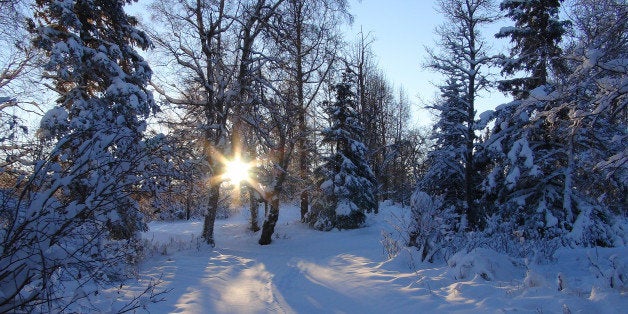
We clamor out of our rental SUV to prepare for another day "in the bog." Michelle, Erin and I don rubber boots, work gloves, and the de rigueur headgear: a baseball cap topped with a mosquito net. Combined with our long-sleeved shirts and long pants, we are way overdressed for the 90-degree interior Alaska summer heat, but well prepared for a day squishing through the sphagnum muck and warding off the thirsty mosquitos.
We have driven about 20 miles on the Parks Highway from Fairbanks, and another six down a continually degrading dirt road to where we parked. After we dress for the day, it is another three-fourths of a mile trek to where our greenhouse gas sensor is set up. The walk starts with a hike on a path on a narrow path through a mixed forest of white spruce, aspen and paper birch. As we slowly descend, the trees become a monoculture of black spruce with a mossy understory. Many of the black spruce are leaning precariously forming a "drunken forest." Once we are in the black spruce, the dirt below our steps is replaced with a Rube Goldberg improvisation of boardwalks (in some stretches just two by sixes laying on the ground). Finally, we enter the clearing that we will call home for the next 10 hours. When we leave in the evening, the sun is still relatively high in the sky, but is less direct and the feet-thick layer of frozen ground below our feet starts to cool the air around us. (The cold beneath is not forgotten if you step off of the boardwalk and hit a spot soft enough that icy water pours over the top of your boots, insuring a miserable day of squishy socks).
This is not most folks' idea of a dream Alaskan vacation. So, why are we here? Our lab designs and builds laser-based sensors that we use for a wide array of applications ranging from biotechnology to diagnostics of fires. At their genesis, these instruments are breadboarded onto heavy optical tables floating on a cushion of compressed air in a completely darkened laboratory in Washington D.C. For many of our creations, it is hard enough to get them to work in this controlled environment. Out here in a thermokarst bog in the middle of Alaska, it is infinitely harder; but somehow we are making measurements.
We are part of a multi-institution team that includes scientists from NASA Goddard Space Flight Center, the University of Alaska, and our team from the Laser Analytics Laboratory at George Washington University. We are not the only ones working here in the Bonanza Creek Experimental Forest this summer. Daily we chat with teams from the University of Washington and the US Geological Survey and compare their studies with our own. What draws us here is the opportunity to assess a rapidly changing ecosystem that arguably is on the front lines of a changing climate. The frozen ground below our feet is part of a massive portion of the earth's land area found in the northern taiga forest, the world's largest biome. This land that stretches across Russia, Alaska, and Canada holds about twice the amount of carbon presently held in the atmosphere. For thousands of years, this forest has been a sink for carbon, taking in more carbon from the atmosphere than it releases back into it. That is changing now, and it is changing rapidly as both the length of the thawing season and the land area covered by thawing land increase every year. As the soil warms, both carbon dioxide and methane, the two most important greenhouse gases, are released into the atmosphere by microbial action on plant material, both "young" (plants that were living recently) and "old" (carbon that has been trapped in frozen plant material for up to thousands of years). Like most studies of the natural world, this is complicated. A longer growing season also means that the trees and moss that cover this region have more opportunity to absorb carbon from the air. This balance is shown in our preliminary measurements this past summer. During the day the carbon dioxide was typically in the low 400 parts per million range, about the average level seen across the globe. However at night, when the sun dips slightly and the air cools into the low 40 degree Fahrenheit range, photosynthesis shuts down and the plants, and the soil beneath them, emit carbon dioxide into the air showing concentrations hundreds of parts per million higher.
You don't need our fancy laser instruments to see the effects of this changing environment. The drunken forest around us is testament to a growing "active layer": the thawed layer above the permafrost where the black spruce have their shallow roots. As the active layer grows and softens, the trees topple and eventually die forming clearings like ours. (This clearing was about half its current size just a few years ago.) Nearby is a large fen where the trees have disappeared completely over many acres.
We will return to this spot next year and hopefully for years to come. We will also be making our measurements farther north in Alaska where the permafrost is more continuous and the thawing season is both shorter and happens later in the summer. By building this long-term record of carbon flux into and out of the taiga, we will better assess the impact of what could be the biggest climate tipping point of the next century.
This post is part of a "Voices from the Lab" series produced by The Huffington Post, in conjunction with the U.N.'s 21st Conference of the Parties (COP21) in Paris (Nov. 30-Dec. 11), aka the climate-change conference. The series will put a spotlight on environmental scientists and their perspectives on climate change, and is part of HuffPost's What's Working editorial initiative. To view the entire series, visit here.